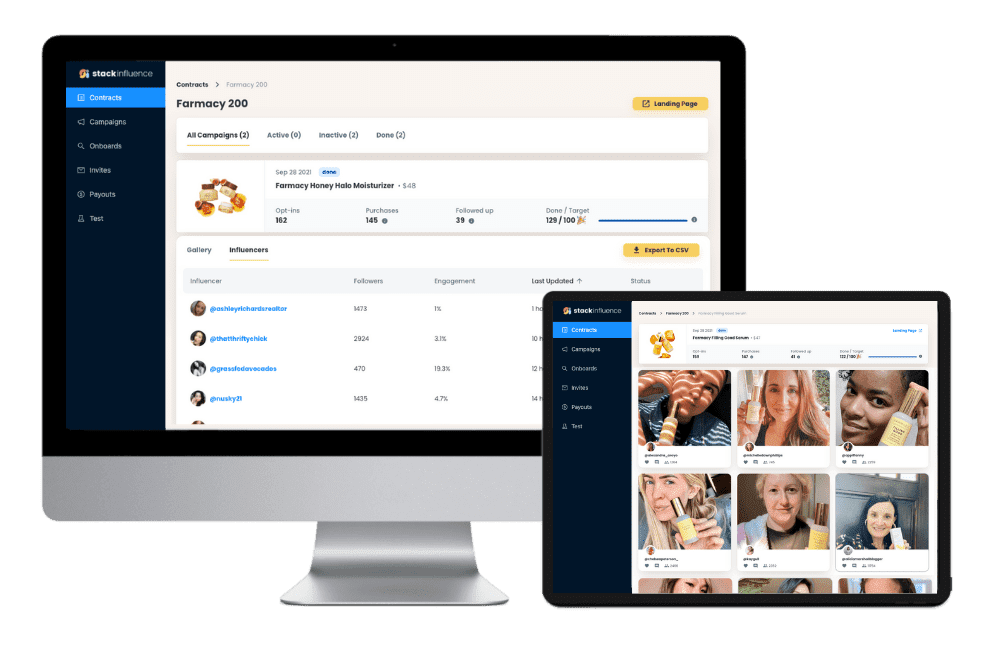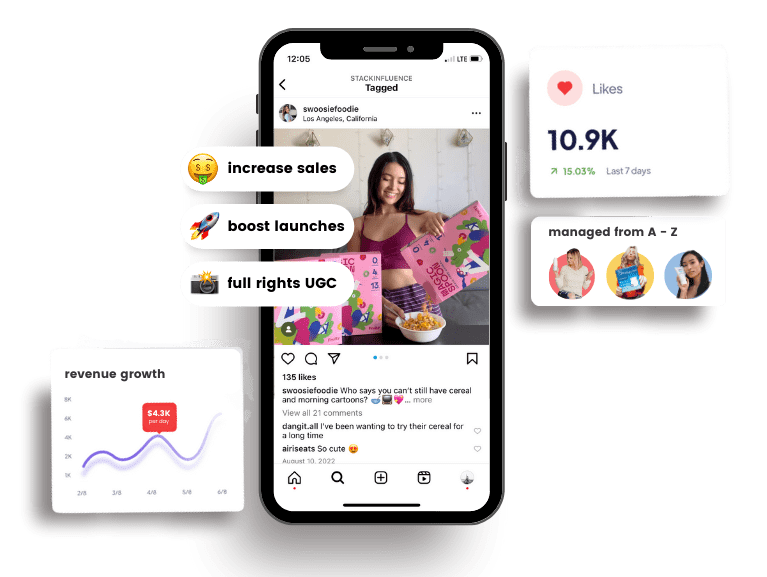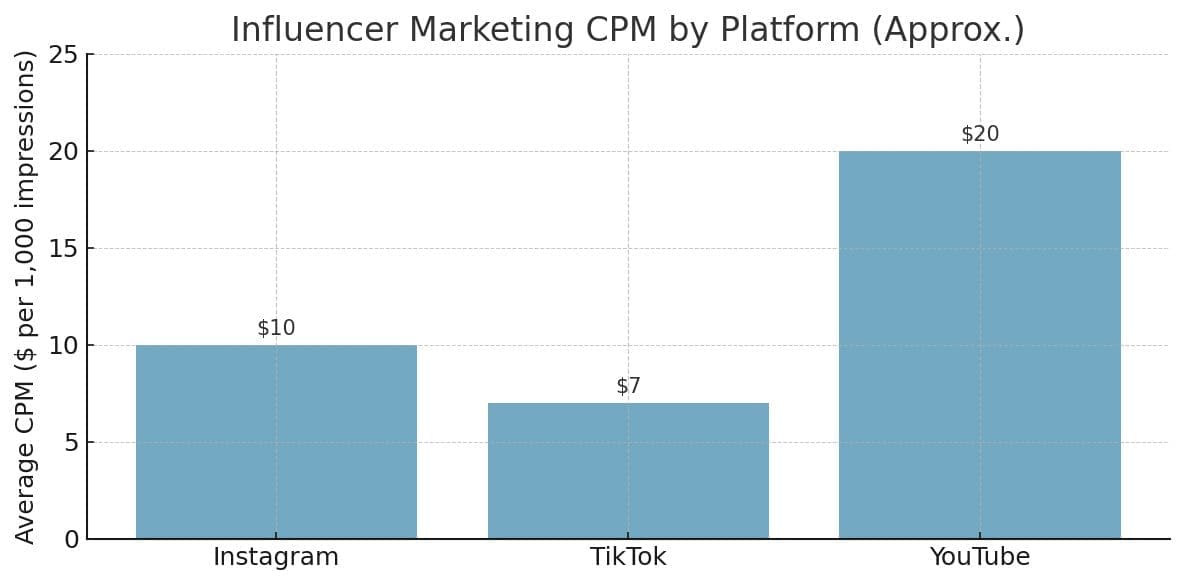CPM in Influencer Marketing for E-Commerce Brands: How to Calculate It & What’s a Good Average
3rd
October, 2025
Influencer Marketing
Amazon Marketplace
Artificial Intelligence
TikTok Tips
When you launch an influencer marketing campaign as an e-commerce brand or Amazon seller, it’s crucial to track key metrics to ensure you’re getting a solid return on investment. One of the most important metrics is Cost Per Mille (CPM) – the cost to reach one thousand impressions. Understanding CPM helps you gauge how cost-effective your influencer collaborations are compared to other marketing channels. In this guide, we’ll explain what CPM means in influencer marketing, how to calculate it, and what a “good” CPM looks like. We’ll also explore how micro-influencers, content creators, and user-generated content (UGC) can help improve your CPM and overall ROI.
What is CPM (Cost Per Mille) in Influencer Marketing?
CPM, meaning “cost per mille” (mille is Latin for thousand), is a standard advertising metric that tells you how much you’re paying for every 1,000 impressions (views) of your content. In influencer marketing, CPM measures the cost to have an influencer’s post seen one thousand times. This metric allows brands to compare the cost-efficiency of influencer campaigns to other forms of advertising on an apples-to-apples basis. For instance, if your influencer campaign has a CPM of $5, that means you spent $5 for every thousand people who saw the content. By contrast, traditional digital ads on platforms like Facebook often have higher CPMs (Facebook’s median CPM is around $7.40 in the U.S.).
CPM is popular because it standardizes your spend per impression. A lower CPM indicates you’re reaching more people for your money, which is usually good. However, not all impressions are equal – an influencer’s authentic post might resonate more with viewers than a generic ad impression. Still, tracking CPM gives you a baseline for cost-effectiveness. It’s one of several metrics (alongside engagement, clicks, and conversions) that e-commerce marketers use to evaluate influencer campaigns.

Unlock the Power of Micro Influencers and Elevate your Brand Today!

Factors That Affect Influencer CPM
Several factors can influence your CPM in influencer marketing. Keep in mind that CPM can vary greatly depending on these variables:
- Influencer Size & Reach: Generally, influencers with larger followings can reach more people with a single post, which can lower the CPM. But they also tend to charge higher fees. Mega-celebrities might have a premium CPM because of their star power, whereas a micro-influencer’s smaller reach might result in a higher CPM unless their rates are very low. (One study found nano-influencers had an average CPM of €329 – extremely high – while macro influencers averaged €47, due to the nano’s limited reach for a given fee.)
- Engagement Rate: An influencer’s engagement rate (how actively their audience likes, comments, and shares) indirectly affects CPM. High engagement can mean the influencer’s audience is more likely to see and trust the content. Often, micro-influencers have engagement rates of 5–20%, far above the ~2% of macro influencers. This can make the impressions more valuable. Brands may accept a higher CPM from an influencer with an engaged, loyal audience, since those impressions carry more impact.
- Content Type & Platform: The format and social platform of the content play a big role in CPM. Video content usually has about 20–30% higher CPM than static images on the same platform, because videos are more engaging and costlier to produce. Platform matters too – for example, Instagram or Facebook posts might have CPMs in the ~$5–$15 range, TikTok content can be around $3–$10, while YouTube videos often command higher CPMs like $10–$30 due to longer view durations and higher production value. (We’ll explore platform averages more in a chart below.)
- Niche and Industry: The influencer’s niche or industry impacts CPM. Some niches (like finance or tech) have higher advertising demand, driving up influencer rates. If an influencer operates in a coveted niche with an audience that’s hard to reach, brands might pay more per impression. For example, an influencer targeting surgeons or enterprise software buyers will likely have a higher CPM than one targeting casual lifestyle content, because the audience is valuable. Highly specialized campaigns often see higher CPMs ($30–$70+) due to the focused reach and greater expected impact.
- Audience Demographics & Location: Who the influencer’s followers are can swing CPM up or down. If the audience has strong purchasing power (e.g. viewers in the USA, Canada, or Western Europe), advertisers pay more to reach them. For instance, audiences in the US, Australia, or Canada often command higher CPMs (around $5–$8), whereas audiences in regions with lower purchasing power (like India or Brazil) might see CPMs as low as $0.50–$2. Advertisers are willing to pay a premium where the viewers are more likely to spend money.
- Campaign Specifics: The details of your campaign will affect CPM. A one-off Instagram post will usually have a different CPM than a long-term campaign with multiple posts, detailed content creation, and usage rights for the content. If you require the influencer to produce multiple videos, allowlist their content for ads, or give exclusivity (meaning they can’t work with your competitors), the cost goes up. These added benefits increase the total cost and thus can raise your CPM. Seasonality plays a part too – during peak periods like Black Friday, increased competition for influencer attention can raise CPM by over 50% as brands bid for limited influencer “inventory”.
Remember that CPM is just one KPI. A high CPM isn’t necessarily bad if those impressions lead to conversions or if the content can be repurposed for additional value. Likewise, a low CPM campaign that delivers tons of cheap impressions is not a win if those impressions don’t engage anyone. Next, let’s look at how to actually calculate your CPM.
How to Calculate CPM in Influencer Marketing
Calculating CPM for an influencer campaign is straightforward math. You need two pieces of data: total cost and total impressions. Once you have those, you plug them into the formula:
CPM = (Total Campaign Cost / Total Impressions) × 1,000
This formula will give you the cost per 1,000 impressions of the influencer content. Let’s break down the steps to calculate it:
- Gather your total campaign cost: Add up everything you spent on the influencer campaign. This includes the fee paid to the influencer, the value of any free products you provided (product seeding costs), shipping, and any other compensation. For example, if you gave the influencer $200 cash and $100 worth of products, your total cost is $300.
- Get the total impressions: Find out how many impressions (views) the influencer’s content generated. An impression means the content was displayed on someone’s screen. Most social platforms provide this data in their analytics. For instance, Instagram Insights or TikTok analytics can show the number of times the post was viewed. Let’s say the post got 30,000 impressions in total.
- Apply the CPM formula: Divide the total cost by total impressions, then multiply by 1,000. Using our example numbers: $300 cost / 30,000 impressions = $0.01 per impression. Multiply by 1,000 to get a CPM of $10. In other words, you spent about $10 for every 1,000 impressions on that influencer post.
For a quick example, imagine you paid a micro-influencer $100 and their sponsored post received 10,000 impressions. The CPM would be (100 / 10,000) × 1,000 = $10 CPM. If another campaign cost $500 and got 100,000 impressions, that CPM would be (500 / 100,000) × 1,000 = $5 CPM. In general, a lower CPM means you got more reach for each dollar spent.
However, CPM alone doesn’t tell the whole story of a campaign’s success. It’s possible to have a low CPM but minimal engagement or zero sales. Conversely, you might have a relatively high CPM but still be happy if that campaign generated a lot of revenue or valuable content. This is why marketers also consider other metrics like engagement rate, click-through rate, cost per click, conversions, and ROI alongside CPM. For example, if an influencer’s audience is highly engaged and trusting, a higher CPM may be justified because each impression carries more weight. Always evaluate CPM in context – it’s a piece of the puzzle, not the entire picture.
What Is a Good CPM for Influencer Marketing?
After calculating your campaign’s CPM, you’re probably wondering: is this number “good”? The truth is, a “good” CPM in influencer marketing depends on your campaign goals, the type of content, and the targeting. There isn’t a single benchmark that fits every situation, but we can discuss general ranges and when a certain CPM might be acceptable.
If your goal is broad brand awareness, you’ll want to keep CPM as low as possible without sacrificing quality. These campaigns cast a wide net, so efficiency is key. A good CPM for awareness-driven campaigns might be in the single digits to mid-teens (roughly $5–$15). In fact, industry analyses show brand awareness efforts often strive for CPM around $5–$20. If you’re getting thousands of eyes on your product for, say, $5 per thousand impressions, that’s quite cost-effective.
On the other hand, for highly targeted campaigns – say, a campaign aimed at driving conversions for a niche product – a higher CPM can still be acceptable. Niche or conversion-focused campaigns often see higher CPMs, in the $30–$70+ range, because you’re paying for more focused access to the right people. For example, a CPM of $50 might be reasonable if you’re reaching a very specific audience (like premium B2B buyers or specialized hobbyists) and those impressions are more likely to turn into sales. The key is that the higher cost per impression is offset by higher conversion rates or larger sales per customer.
Most campaigns will fall somewhere in between. A “middle of the road” CPM for general influencer marketing across industries tends to range from a few dollars up to around $10. One report in 2024 found the average influencer marketing CPM was about $4.63 across platforms, which was a drop from the previous year and even lower than many Facebook Ads CPMs. Many brands today find that well-run influencer campaigns can match or beat the CPM of traditional ads in cost-efficiency, especially when working with many micro-influencers. As a rule of thumb, if your CPM is hovering in the single-digit dollars (let’s say $2–$10), you’re within a pretty normal range. If it’s significantly higher, you should ask why – are you in a super-targeted niche? Did you pay extra for content rights or exclusivity? Or is there a way to optimize costs?

Figure: Example CPM ranges by campaign objective. Broad brand awareness campaigns emphasize a low CPM (often in the $5–$15 range) to maximize reach. Engagement-driven campaigns might accept a slightly higher CPM ($10–$30) if those impressions lead to more likes, comments, and shares from a highly involved audience. Niche/targeted campaigns and conversion-focused campaigns often have higher CPMs (ranging $30 up to $50–$70+ in some cases) because they aim to reach a specific, valuable audience or drive actual sales. In those cases, a higher cost per impression is justified by the greater expected impact per viewer. The optimal CPM for your campaign will balance cost with quality of impressions – a “good” CPM is one that helps meet your objectives without overspending.
It’s also useful to consider how platform choice affects what a good CPM looks like. Influencer marketing costs can differ between Instagram, TikTok, YouTube, etc. For example, a $10 CPM on Instagram might be quite standard, but that same $10 CPM on TikTok could be on the higher side (since TikTok often yields very cheap impressions), while on YouTube $10 would be considered low. To illustrate, here are approximate average CPMs by platform for influencer content:

Figure: Approximate average CPMs for influencer content on different social platforms. Instagram content often sees around a $5–$15 CPM (roughly $10 on average, similar to Instagram’s own ad rates). TikTok posts tend to be highly cost-efficient, with many campaigns averaging around a $3–$10 CPM (TikTok’s algorithmic reach can drive lots of views, keeping CPM low). YouTube influencer videos usually command higher CPMs about $10–$30+, reflecting the greater effort to produce videos and the longer engagement time per impression. When evaluating your CPM, consider the platform norms – a “good” CPM on one platform might differ on another.
Ultimately, a good CPM is one that aligns with your goals. If you’re just trying to spread awareness widely, you want that number as low as possible. If you’re targeting a niche or aiming for conversions, you might tolerate a higher CPM in exchange for quality impressions. Always compare your CPM to campaign outcomes: are those impressions translating into engagement or sales? Also compare to industry benchmarks when available – for instance, if your industry’s average CPM is $8 and you’re getting $5, you’re doing well. If you’re paying $25 when others average $5, it’s time to dig deeper and optimize.
Maximizing ROI with Micro-Influencers, UGC, and Smart CPM Management
For e-commerce brands and especially scrappy Amazon sellers, working with micro-influencers (or even nano-influencers) can be a game-changer for CPM and overall ROI. Micro-influencers are creators with smaller followings (typically in the 5,000 to 100,000 range) who often charge much less per post than big “macro” influencers. Interestingly, campaigns that leverage many micro-influencers often achieve a very competitive CPM – sometimes even lower than what a single big influencer or paid ads would cost. Here’s why micro-influencers and content creators can lead to better cost-efficiency:
- Lower Costs per Influencer: Many micro-influencers are willing to collaborate in exchange for just free products or a modest fee, especially if they genuinely like your brand. For example, instead of paying one celebrity $50,000 for a post, an e-commerce brand might send 100 micro-influencers a $100 product each (total $10,000 in product costs) and get 100 posts in return. The impressions from those 100 smaller creators combined can rival or exceed the celebrity’s reach – often at a much lower total cost. That can drive the average CPM way down. In fact, brands often find micro-influencers to be the most cost-effective tier on a CPM basis when campaigns are executed smartly. One dataset showed micros (and mid-tier influencers) delivering CPMs mostly in the $5–$15 range, which is highly efficient.
- Better Engagement & Authenticity: Micro-influencers typically have higher engagement rates and closer relationships with their followers. Their content feels more like a peer recommendation than an ad, which leads to followers paying closer attention. This means each impression from a micro-influencer could be more influential per person. As noted earlier, a higher engagement can justify a higher CPM because those impressions have quality. The good news is micro-influencer content often gives you both: a lower CPM and strong engagement. According to one source, while CPMs vary, micro-influencers generally deliver lower CPMs alongside better engagement levels compared to mega-influencers. It’s a win-win for an e-commerce brand – you’re paying less per impression, and those impressions are more likely to convert.
- User-Generated Content (UGC) Goldmine: One often overlooked benefit of influencer campaigns – especially with micro-influencers – is the content itself. The photos, videos, reviews, unboxing stories, etc., created by influencers are authentic user-generated content that you can leverage beyond the initial Instagram or TikTok post. You can repost this content on your own social media, feature it on your product pages, or even run it as ads. In fact, UGC-based ads (ads that use real user content or testimonials) tend to outperform traditional ads – they often get higher click-through rates and lower cost-per-click because they feel more genuine. So, even if your CPM with micro-influencers was, say, slightly higher than your Facebook Ads CPM, you might still come out far ahead because you’ve acquired a library of persuasive UGC. That content builds trust with other consumers and keeps working for you long after the influencer’s original post. For example, an influencer’s product demo video or before-and-after photo can be repurposed in your Amazon listing or website, boosting conversions for future shoppers. Consider that part of your return on investment – it’s not just impressions you’re buying, but assets and social proof.
- Stacking the “Micro” Advantage: By collaborating with multiple micro-influencers, brands can effectively create a tapestry of niche audiences that add up to broad reach. The CPM in such scaled campaigns can be very attractive. A recent trend has been brands running product seeding campaigns – giving free product to dozens or hundreds of micro-influencers who then post about it. This often yields a flood of authentic content and word-of-mouth at a very low cost. Platforms like Stack Influence specialize in managing these kinds of micro-influencer campaigns for e-commerce sellers, automating product-for-post exchanges. According to Stack Influence, compensating micro-influencers with your product not only lowers monetary costs but also results in genuine posts that feel like real consumer experiences – essentially word-of-mouth marketing at scale. In turn, these genuine posts spark more organic conversations about your product, further amplifying your reach without additional spend.
It’s worth noting that working with many micro-influencers does require coordination – you have to recruit the creators, ship products, track their posts, and measure results across the board. Using an influencer marketing platform or agency (such as Stack Influence or others) can streamline this process by vetting influencers, handling outreach, and ensuring each creator delivers content, all while you monitor the combined impact. The end result can be a very low blended CPM for the campaign and a trove of UGC and testimonials to boost your marketing materials.
Finally, keep an eye on overall ROI. CPM is a piece of that, and micro-influencer campaigns have shown impressive ROI in many cases. Some studies report micro/nano-influencer campaigns yielding around a 20:1 return on investment (every $1 spent brings $20 in revenue), far outperforming the ~6:1 ROI seen with macro-influencers. That higher ROI comes from the combination of relatively low costs, highly trusted recommendations, and the extra value of content and social proof. So, while managing dozens of smaller influencers might seem like more work than hiring one big name, the numbers often speak for themselves.
Tip: Whether you work with micro-influencers or celebrities, always negotiate and use data. If an influencer’s initial rate would lead to an unreasonably high CPM, don’t be afraid to discuss a lower fee or added deliverables. Sometimes offering a longer-term partnership or swapping cash for free products can improve your CPM significantly. For example, instead of paying $1,000 for one post, a brand might pay $1,200 for three posts over three months – getting more impressions for only a bit more cost, thus reducing CPM. Or by sending product gifts in lieu of some payment, you can reduce monetary cost. Be creative with your influencer collaborations to keep CPM in check while maintaining authenticity and results.

Unlock the Power of Micro Influencers and Elevate your Brand Today!

Conclusion to CPM in Influencer Marketing for E-Commerce Brands
In summary, CPM is a powerful metric for influencer marketing, especially for e-commerce brands looking to maximize every dollar. By understanding what drives CPM up or down, calculating it accurately, and benchmarking what “good” looks like, you can make smarter decisions about which influencers to partner with and how to structure those deals. Combine that with the strategic use of micro-influencers and the rich UGC they create, and you have a recipe for influencer campaigns that not only reach a lot of people cost-efficiently, but also resonate with consumers and drive action. Happy collaborating, and may your CPMs be ever in your favor!

By William Gasner
CMO at Stack Influence
William Gasner is the CMO of Stack Influence, he's a 6X founder, a 7-Figure eCommerce seller, and has been featured in leading publications like Forbes, Business Insider, and Wired for his thoughts on the influencer marketing and eCommerce industries.
Want new articles before they get published? Subscribe to our Awesome Newsletter.
stack up your influence
turning creativity into currency
our headquarters
111 NE 1st St, Miami, FL 33132
our contact info
[email protected]
stack up your influence
turning creativity into currency
our headquarters
111 NE 1st St, 8th Floor
Miami, FL 33132


